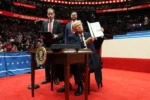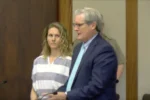Imagine a big courtroom where important decisions are made about the government! Recently, a federal judge named Carl Nichols made a huge ruling that was like a victory for the Trump administration. He decided that the government can move forward with its plans to change the U.S. Agency for International Development, or USAID for short. This decision followed a lawsuit from some workers who believed their rights were being threatened. Let’s dive into what happened next and learn how this affects the people working at USAID and what it means for the government!
| Category | Details |
|---|---|
| Event | Federal judge dissolves restraining order and denies injunction related to USAID. |
| Judge | U.S. District Judge Carl J. Nichols, appointed by Donald Trump. |
| Date | February 21, 2025 |
| Plaintiffs | Two government employee unions led by the American Foreign Service Association. |
| Lawsuit Claims | Accusations of unlawful actions by Trump, exceeding presidential and legislative authority. |
| Initial Ruling | Temporary restraining order granted to prevent USAID employee changes and funding pauses. |
| Final Ruling | Judge vacated the restraining order, stating plaintiffs did not prove irreparable harm. |
| Legal Terms | ‘Irreparable harm’ means damage that cannot be fixed with money. |
| Judge’s Findings | Claims of harm were overstated; no mandatory recall for USAID employees abroad. |
| Employee Options | USAID employees abroad can choose to return to the U.S. within 30 days with agency-funded travel. |
Understanding the Judge’s Decision
The recent ruling by U.S. District Judge Carl J. Nichols has significant implications for the future of the U.S. Agency for International Development, or USAID. In his decision, Judge Nichols lifted a temporary restraining order that had initially protected USAID employees from certain government actions. This means that the Trump administration can now proceed with its plans to reorganize USAID without facing immediate legal obstacles. The judge’s opinion emphasized that the claims of harm made by the unions were exaggerated, which played a crucial role in his decision.
Judge Nichols pointed out that the unions representing USAID employees had not proven that their members would face ‘irreparable harm’ due to the government’s actions. He explained that the legal systems already in place for resolving employment disputes should be the proper path for these employees to voice their concerns. This ruling suggests that the government can move forward with its restructuring plans while the unions need to find appropriate legal channels to address their grievances.
The Role of Employment Laws
In his ruling, Judge Nichols referenced important employment laws that govern how disputes between federal workers and the government are handled. These laws include the Federal Service Labor-Management Relations Statute and the Civil Service Reform Act. According to the judge, these laws provide a framework for resolving labor disputes, meaning that issues raised by the unions should be directed to the specific agencies designed to handle such matters. This legal structure is intended to protect workers while balancing the powers of the government.
The judge’s opinion highlights that even when claims involve larger constitutional questions, the immediate concerns of the employees relate to their job conditions. By directing the unions to the established dispute resolution systems, Judge Nichols reinforced the idea that employment-related issues should be dealt with through the appropriate legal channels, rather than through broad judicial interventions. This approach underscores the importance of following the proper legal procedures in employment disputes.
The Impact of Misrepresentation
A key aspect of Judge Nichols’ ruling was addressing the unions’ claims, which he found to be overstated. He indicated that some assertions made by the plaintiffs regarding the urgency of USAID employees returning home were misleading. For instance, the claim that over 1,400 employees would be required to return to the U.S. within 30 days was proven false. Instead, the reality is that these employees have the option to return voluntarily, which changes the narrative surrounding the perceived urgency and threat of harm.
This misrepresentation of facts not only affected the court’s view on the unions’ claims but also highlighted the importance of accurate information in legal proceedings. By clarifying the actual situation for USAID employees, the judge reinforced the idea that exaggerated claims can weaken a case. This outcome serves as a reminder that clear and truthful communication is essential, especially in contexts where the stakes involve the rights and jobs of federal employees.
Understanding the Legal Framework of Employment Disputes
The recent ruling by Judge Nichols sheds light on the complex legal frameworks governing employment disputes involving federal employees. Specifically, the Federal Service Labor-Management Relations Statute (FSLMRS) and the Civil Service Reform Act (CSRA) provide comprehensive guidelines for resolving these disputes. These statutes establish mechanisms through which unions can address grievances related to labor conditions, ensuring that federal workers have a structured way to voice their concerns without resorting to litigation as a first step.
In the case at hand, the court emphasized that the proper channels for addressing employment-related issues should be utilized before escalating matters to a broader constitutional debate. This approach not only preserves the integrity of the established legal frameworks but also encourages a more efficient resolution of disputes. By redirecting the unions’ focus towards the appropriate agencies, such as the Federal Labor Relations Authority (FLRA) and the Merit Systems Protection Board (MSPB), the ruling reinforces the importance of the existing systems designed to protect civil servants.
Implications for the Future of USAID and Federal Employment
Judge Nichols’ decision to dissolve the restraining order has significant implications for the future of USAID and the broader landscape of federal employment. With the ruling allowing the Trump administration to proceed with its plans, it raises questions about the potential restructuring of USAID and its influence on international development efforts. As the agency faces changes, employees may need to adapt to new policies, which could impact their roles and responsibilities in global missions.
Moreover, the ruling highlights the precarious balance between executive power and the protection of employee rights within federal agencies. As the government continues to navigate its objectives, the outcome of this case may set a precedent for how similar disputes are handled in the future. It emphasizes the need for federal employees to remain vigilant and informed about their rights, as changes in administration can lead to shifts in policies that directly affect their work and job security.
The Role of Judicial Review in Executive Actions
The recent ruling by Judge Nichols illustrates the essential role of judicial review in checking executive actions. In this case, the judge underscored that while the executive branch holds substantial authority, its actions are still subject to scrutiny, particularly when they affect the rights of federal employees. The court’s analysis of the claims presented by the unions also reflects a broader judicial responsibility to ensure that constitutional principles are upheld, even amidst significant political changes.
This case exemplifies how courts can act as a safeguard for civil service employees, ensuring that their rights are not undermined by executive overreach. By denying the preliminary injunction, the judge emphasized the need for plaintiffs to demonstrate actual harm, reinforcing the notion that legal protections exist within a framework that prioritizes accountability and fairness. As such, this ruling serves as a reminder of the judiciary’s critical function in maintaining the balance of power among the branches of government.
Evaluating the Claims of Irreparable Harm
In his ruling, Judge Nichols critically evaluated the unions’ claims of irreparable harm, concluding that these assertions were exaggerated. The court found that the plaintiffs failed to demonstrate that their members would suffer significant injury from the proposed changes at USAID. This assessment is crucial because the legal concept of ‘irreparable harm’ is a key determinant in granting injunctive relief; if such harm is not substantiated, the court is less inclined to intervene.
The judge’s analysis not only highlights the need for solid evidence in legal claims but also underscores a broader principle of judicial restraint. By requiring the unions to provide clear and convincing evidence of harm, the ruling establishes a precedent that discourages speculative claims that lack substantive backing. This decision reinforces the idea that courts must prioritize factual integrity and legal standards when deliberating on issues involving federal employment and executive actions.
Frequently Asked Questions
What is USAID and what does it do?
**USAID**, or the U.S. Agency for International Development, helps countries around the world by providing **aid** for things like health, education, and disaster relief. This support aims to improve people’s lives and help communities grow.
Why did the judge dissolve the restraining order against USAID?
The judge decided to dissolve the **restraining order** because he believed that the claims made by the unions were not strong enough to prove they would be seriously harmed. This allowed the government to continue its plans.
What do the unions say about the Trump administration’s actions?
The unions argue that the Trump administration is acting **unlawfully** by trying to change how USAID works without proper authority from Congress, which they believe goes against the rules set by the **Constitution**.
What are labor disputes and how are they resolved?
**Labor disputes** are disagreements between workers (or their unions) and their employers. They are usually resolved through a special government agency called the **Federal Labor Relations Authority** (FLRA), which helps manage these conflicts fairly.
What did the judge say about the claims made by the unions?
The judge mentioned that the unions’ claims about harm were **exaggerated**. He pointed out that many of their fears were not happening, like workers being forced to return to the U.S. immediately.
What does ‘irreparable harm’ mean in this context?
**Irreparable harm** means damage that cannot be fixed or paid for with money. In court, showing that a person will suffer this kind of harm helps determine whether they should receive special help.
What is the role of Congress regarding USAID?
**Congress** has the power to create laws that guide how USAID operates. They make sure that actions taken by the government, like changes to employment or funding, follow these laws to protect workers and aid programs.
Summary
A federal judge in Washington, D.C., ruled in favor of the Trump administration, allowing it to proceed with dismantling the U.S. Agency for International Development (USAID). Judge Carl J. Nichols vacated a temporary restraining order and denied a preliminary injunction sought by two government employee unions, arguing they failed to demonstrate irreparable harm. The ruling emphasized that employment disputes should be resolved through established federal processes rather than court. The judge found that initial claims of harm by the unions were exaggerated, clarifying that no mandatory recall notice for overseas USAID employees was in effect.







